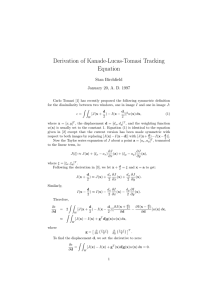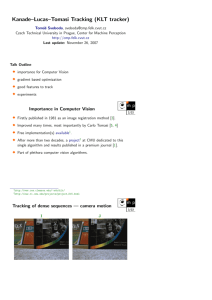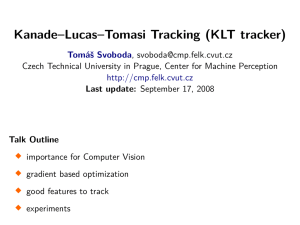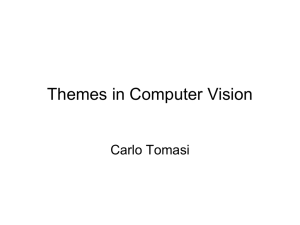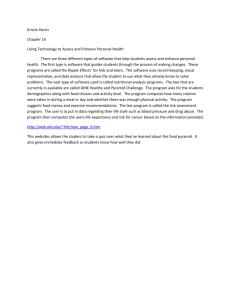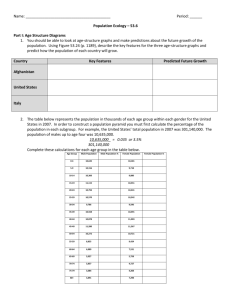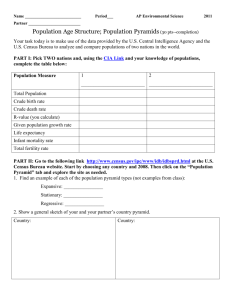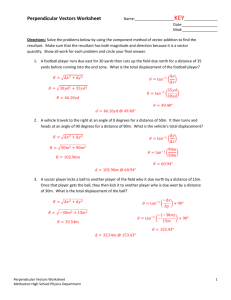Motion Tracking - School of Computing
advertisement
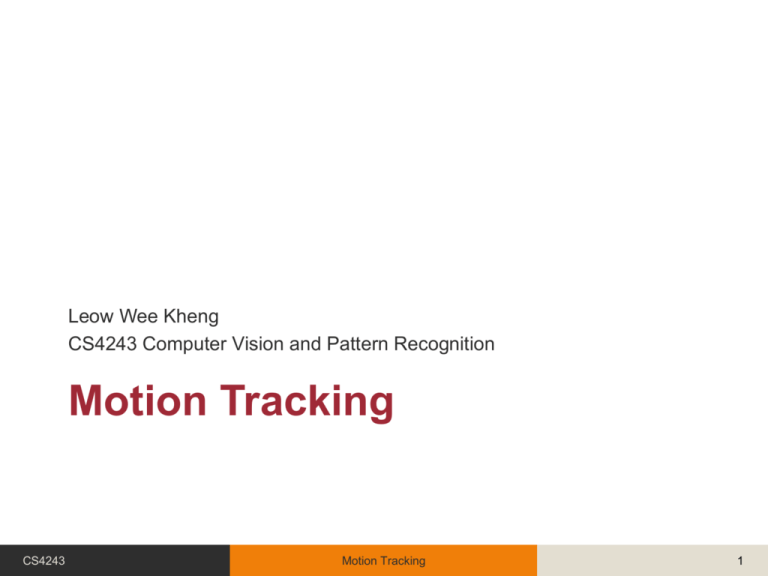
Leow Wee Kheng CS4243 Computer Vision and Pattern Recognition Motion Tracking CS4243 Motion Tracking 1 Changes are everywhere! CS4243 Motion Tracking 2 Illumination change CS4243 Motion Tracking 3 Shape change CS4243 Motion Tracking 4 Object motion CS4243 Motion Tracking 5 Camera motion CS4243 Motion Tracking 6 Object & camera motion CS4243 Motion Tracking 7 Everything changes! CS4243 Motion Tracking 8 Motion analysis is tough in general! We focus on object / camera motion. CS4243 Motion Tracking 9 Change Detection Detects any change in two video frames. Straightforward method: Compute difference between corresponding pixels: : intensity / colour at (x, y) in frame t. > threshold, has large difference. If CS4243 Motion Tracking 10 Any difference? No CS4243 Motion Tracking 11 Any difference? Yes, illumination change CS4243 Motion Tracking 12 Any difference? Yes, position change CS4243 Motion Tracking 13 Change Detection Can detect Illumination change Position change Illumination and position change But, cannot distinguish between them. Need to detect and measure position change. CS4243 Motion Tracking 14 Motion Tracking Two approaches Feature-based Intensity CS4243 gradient-based Motion Tracking 15 Feature-based Motion Tracking Look for distinct features that change positions. Eagle’s wing tips change positions. Tree tops don’t change positions. CS4243 Motion Tracking 16 Basic Ideas 1. Look for distinct features in current frame. 2. For each feature CS4243 Search for matching feature within neighbourhood in next frame. Difference in positions → displacement. Velocity = displacement / time difference. Motion Tracking 17 Basic Ideas displacement feature area search area CS4243 Motion Tracking 18 What feature to use? Harris corner Tomasi’s feature Feature descriptors: SIFT, SURF, GLOH, etc. Others CS4243 Motion Tracking 19 Summary Simple algorithm. Can be slow if search area is large. Can constrain search area with prior knowledge. CS4243 Motion Tracking 20 Gradient-based Motion Tracking Two basic assumptions Intensity changes smoothly with position. Intensity of object doesn’t change over time. Suppose an object is in motion. Change position (dx, dy) over time dt. Then, from 2nd assumption: Apply CS4243 Taylor’s series expansion: Motion Tracking 21 Omit higher order terms and divide by dt Denote Then, u, v are unknown. 2 unknowns, 1 equation: can’t solve! CS4243 Motion Tracking 22 Any difference in motion? CS4243 Motion Tracking 23 Any difference in motion? CS4243 Motion Tracking 24 Any difference in motion? CS4243 Motion Tracking 25 Any difference in motion? CS4243 Motion Tracking 26 Any difference in motion? CS4243 Motion Tracking 27 Any difference in motion? CS4243 Motion Tracking 28 Aperture Problem Homogeneous region Ix = Iy = It = 0. No change in local region. Cannot detect motion. CS4243 Motion Tracking 29 Aperture Problem Edge Ix and Iy are zero along edge Cannot measure motion tangential to edge Ix and Iy are non-zero normal to edge Can measure motion normal to edge So, cannot measure actual motion CS4243 Motion Tracking 30 Aperture Problem Corner Ix and Iy are non-zero in two perpendicular directions 2 unknowns, 2 equations Can measure actual motion CS4243 Motion Tracking 31 Lucas-Kanade Method Consider two consecutive image frames I and J: I J x+d d x x moves from x = (x, y)T to x + d. d = (u, v) T Object CS4243 Motion Tracking 32 So, Or Due to noise, there’s an error at position x: Sum error over small window W at position x: Similar to template matching CS4243 weight Motion Tracking 33 If E is small, patterns in I and J match well. So, find d that minimises E: ∂E / ∂d = 0, compute d that minimises E. First, expand I(x – d) by Taylor’s series expansion: Set Omit higher order terms: Write in matrix form: Intensity gradient CS4243 Motion Tracking 34 Now, error E at position x is: Now, differentiate E with respect to d (exercise): Setting ∂E / ∂d = 0 gives b the only unknown Z CS4243 Motion Tracking 35 So, 2 CS4243 we get unknowns, 2 equations. Can solve for d = (u, v). What happen to aperture problem? Did it disappear? Motion Tracking 36 Lucas-Kanade + Tomasi Lucas-Kanade algorithm is often used with Tomasi’s feature Apply Tomasi’s method to detect good features. Apply LK method to compute d for each pixel. Accept d only for good features. CS4243 Motion Tracking 37 Example Can you spot tracking errors? CS4243 Motion Tracking 38 Constraints Math of LK tracker assumes d is small. In implementation, W is also small. LK tracker is good only for small displacement. CS4243 Motion Tracking 39 How to handle large displacement? What if we scale down images? Displacements CS4243 are smaller! Motion Tracking 40 Image Pyramid Usually, smoothen image with Gaussian filter before scaling down. downsample scaled image input image CS4243 Motion Tracking 41 LK Tracking with Image Pyramid CS4243 Motion Tracking 42 Construct image pyramids. Apply LK tracker to low-resolution images. Propagate results to higher-resolution images. Apply LK tracker to higher-resolution images. CS4243 Motion Tracking 43 Example Tracking results are more accurate. CS4243 Motion Tracking 44 Summary Efficient algorithm, no explicit search. Has aperture problem; track good features only LK tracker can’t track large displacement. Use LK + image pyramid for large displacement. CS4243 Motion Tracking 45 Software OpenCV supports LK and LK with pyramid. [Bir] offers LK with Tomasi’s features & pyramid. CS4243 Motion Tracking 46 Appendix Calculation of Ix, Iy, It Use finite difference method Forward difference Ix = I(x + 1, y, t) − I(x, y, t) Iy = I(x, y + 1, t) − I(x, y, t) It = I(x, y, t + 1) − I(x, y, t) Backward difference Ix = I(x, y, t) − I(x − 1, y, t) Iy = I(x, y, t) − I(x, y − 1, t) It = I(x, y, t) − I(x, y, t − 1) CS4243 Motion Tracking 47 Further Readings Lucas-Kanade tracking with pyramid: [BK08] Chapter 10. Optical flow: [Sze10] Section 8.4. Hierarchical motion estimation (with image pyramid): [Sze10] Section 8.1.1. CS4243 Motion Tracking 48 References [Bir] S. Birchfield. KLT: An implementation of the Kanade-LucasTomasi feature tracker. http://vision.stanford.edu/~birch/klt/. [BK08] Bradski and Kaehler. Learning OpenCV: Computer Vision with the OpenCV Library. O’Reilly, 2008. [LK81] B. D. Lucas and T. Kanade. An iterative image registration technique with an application to stereo vision. In Proceedings of 7th International Joint Conference on Artificial Intelligence, pages 674– 679, 1981. [ST94] J. Shi and C. Tomasi. Good features to track. In Proceedings of IEEE Conference on Computer Vision and Pattern Recognition, pages 593–600, 1994. [Sze10] R. Szeliski. Computer Vision: Algorithms and Applications. Springer, 2010. CS4243 Motion Tracking 49 References CS4243 [TK91] C. Tomasi and T. Kanade. Detection and tracking of point features. Technical Report CMU-CS-91-132, School of Computer Science, Carnegie Mellon University, 1991. Motion Tracking 50
